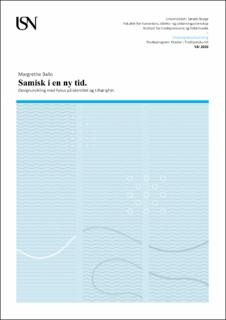| dc.description.abstract | This thesis is concerned with how cultural identity and affiliation can be used as a starting point to develop garments with a background in sami culture and how young people today see the culture as a basis for further development of traditional attire. Sami culture and identity is a difficult subject for many. Because of this I wish to explore how we today can communicate sami culture and highlight sami cultural identity and affiliation through clothes. This thesis consists of two parts, one practical and one written. The practical part is within the field of textile with a focus on sami traditional apparel. The sami national costume, the kofte, is the basis for the development of the design. The kofte is emphasized because this garment is a strong cultural marker and has deep meaning for many sami people. The written part explores empiricism and theory concerning identity and affiliation and how this appears in garments so people with different connections to sami culture can find their place within it.
Do young sami people today have an open road ahead of them? What will the future be for sami culture? Will sami culture disappear if inspiration and impulses from society at large is “let in” or would that give the culture something new to build upon? Will new design make the culture more exciting for young sami people today and in the future? These are the questions that creates the basis for this thesis and the research question.
The research question is as follows:
How can I, through design and form of expression, create garments that show a connection to sami folk costume-tradition and can be used by sami people and others who wish a closer connection to sami culture?
--
Dát dutkkus gieđahallá mo identitehta ja gullevašvuohta sáhttá geavahuvvot biktasiid ovdánahttimis mas lea vuođđun sámekultuvra ja mo nuorra sápmelaččat odne oidnet kultuvrra vuolggasadjin bivttasárbevieruid ovdánahttimis. Sáme kultuvra ja identitehta lea váttis ášši máŋgasiidda. Dan sivas háliidan suokkardit mo mii odne sáhtašeimmet viidásut gaskkustit sáme kultuvrra ja loktet oidnosii sáme identitehta- ja gullevašvuođa biktasiid bokte. Dutkosis leat guokte oasi praktihkalaš ja čálalaš oasit. Praktihkalaš oassi lea tekstiillas ja mas lea sáme bivttasárbevieru lahkaneapmi. Sáme árbevirolašbivttas, gákti, lea vuolggasadjin hábmenahtanuššamis. Gákti geavahuvvo váldodeaddun danne go dát bivttas lea nano kultuvrra dovdomearkan ja mas lea stuorra mearkkašupmi ollu sápmelaččaide. Čálalaš oassi lea teoriija ja empiriija birra mii lea čatnasan identitehtii ja gullevašvuhtii, ja mo dat boahtá oidnosii biktasiin vai olbmot geain lea ieš guđet čatnasat sáme kultuvrii gávdnet iežaset saji.
Lea go nu ahte otná nuorra sápmelaččain lea rabas geaidnu ovddabealde? Ja mo šaddá leat sámevuođa boahtte áigi? Jávká go sámevuohta jus inspirašuvdna ja impulssat stuorraservodagas “besset sisa”, vai addá go dat baicce kultuvrii ođđa huksenvuođu? Dahká go ođđa hábmen kultuvrra gelddolabbon nuorra sápmelaččaide odne ja boahtte áiggis? Diet gažaldagat lea dutkamuššii vuođđun ja čuolbmačilgehussii. Dat čuodjá čuovvovaš láhkai:
Mo sáhtán mun hábmema bokte ja olggosbuktinvugiiguin ráhkadit biktasiid mat čájehit gullevašvuođa bivttasárbevirrui ja mat galget sáhttet geavahuvvot sápmelaččain ja earáin geat háliidit lagabut gullevašvuođa sáme kultuvrii? | en_US |
